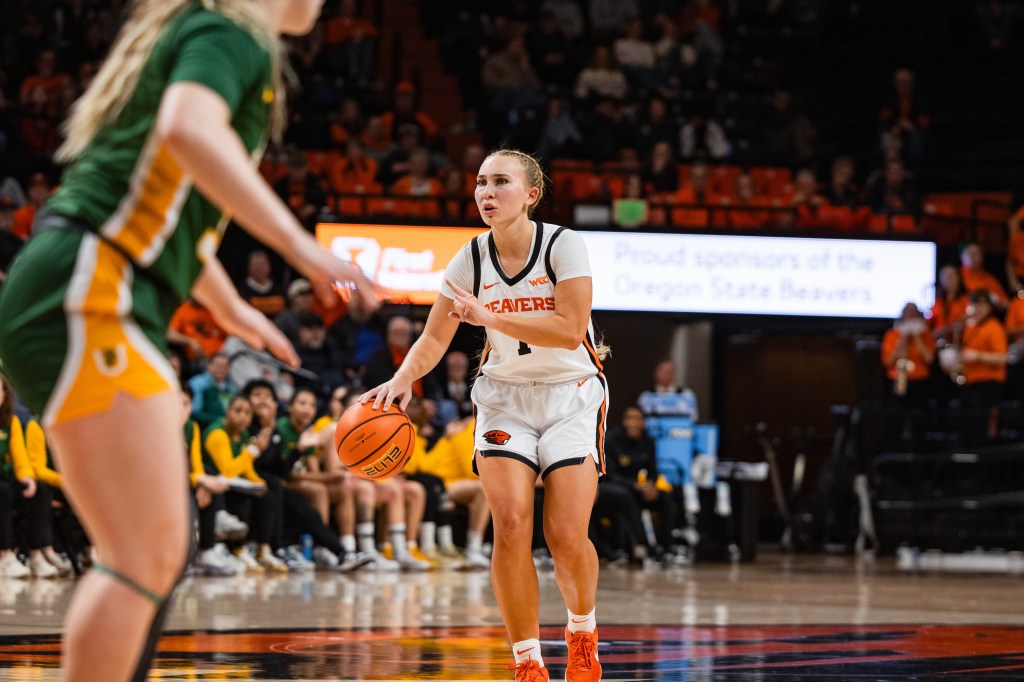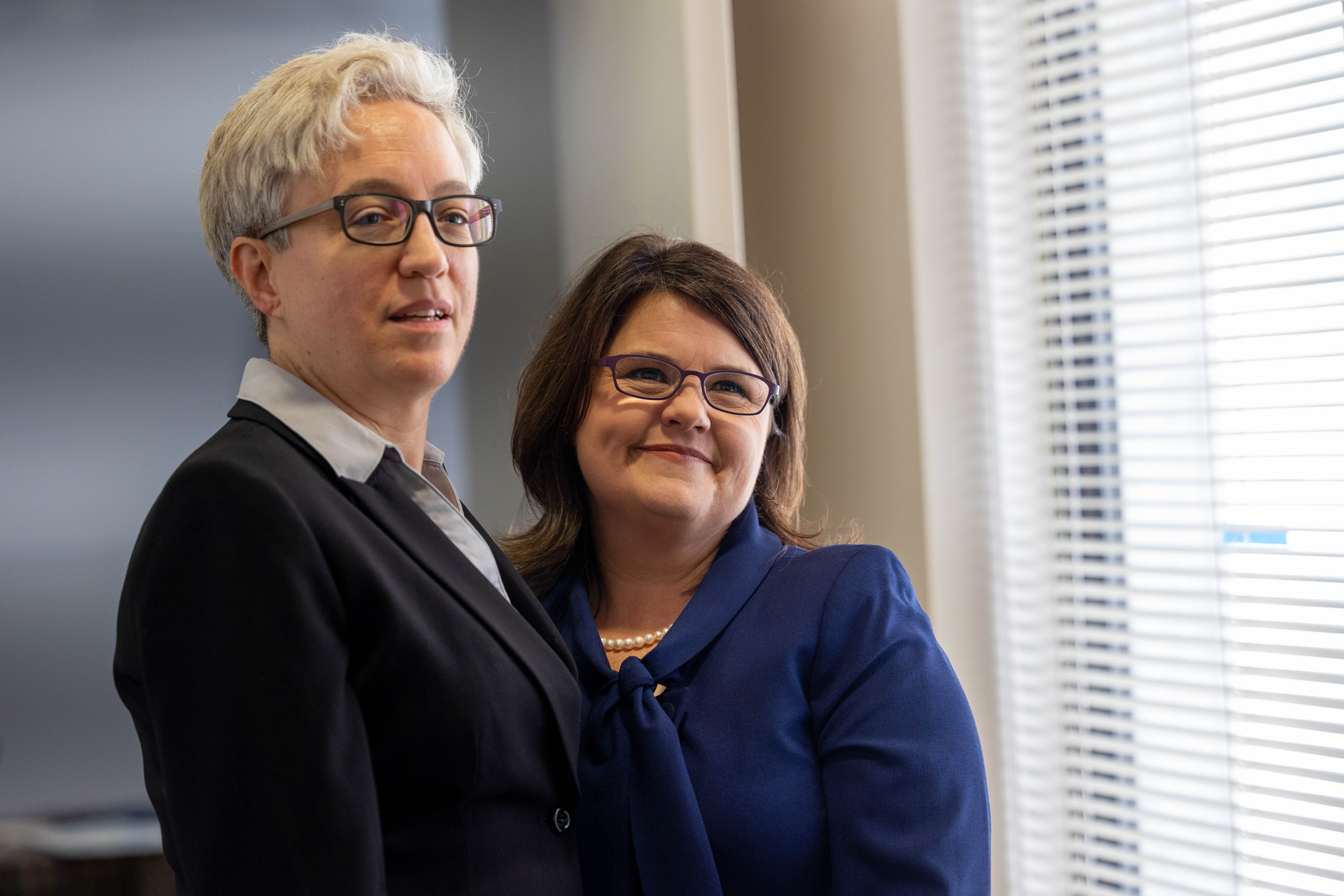Oregon State women’s basketball’s offseason retooling
Published 3:15 pm Wednesday, May 28, 2025

- Oregon State's Kennedie Shuler brings the ball up the court against San Francisco during the 2024-25 season. Entering her junior season, Beavers head coach Scott Rueck says he wants Shuler to grow more confident as a shooter (Courtesy photo, Oregon State Athletics)
The reorganization of the Pac-12 Conference is still, roughly, 18 months away for women’s basketball.
The crested logo of the “Conference of Champions” remains on the hardwood of Oregon State’s Ralph Miller Court at Gill Coliseum. Next to it, the typeface of the West Coast Conference’s own banner. Aside from providing fodder for distant-future bar trivia answers for college sports fans, the two conference affiliations on one court serve as a reminder of what was, what currently is, and what lies ahead for Beaver basketball.
While the WCC logo’s will occupy a place on the court for one more season, the Beavers’ time as adopted members of the WCC — and more specifically, its conference tournament trophy — remain etched into Oregon State women’s basketball’s history for good. The 2025 WCC conference tournament trophy also has its place as a reminder.
A reminder that the hard part of conference-realignment may be over for Beavers’ head coach Scott Rueck.
He already rebuilt the team, now he’s reloading it.
The transfer portal dismantled 2023-24’s Elite Eight squad, with Rueck trading a hypothetical “run-it-back” juggernaut of a roster for one he and his staff were forced to reassemble. Triumphantly, Rueck’s 2024-25 roster — built around the five who stayed and fleshed out with young homegrown talent and transfers ranging from the JUCO ranks to the Power Five — claimed a conference tournament championship and a return to March Madness.
Getting the band back together
Now it’s the end of May. The Beavers are still closer to having cut down a net in Las Vegas than they are raising a banner into Gill’s rafters to kick off another season. Regardless of the some five months until they retake the court, one of Rueck’s favorite sorts of preparations — offseason workouts — are underway for Oregon State’s 2025-26 roster-reload and WCC farewell tour.
“Honestly, this individual time with each of our players is so important,” Rueck told The Portland Tribune earlier this month. “I’m loving it because there’s so much focused interaction where you’re just building the player-coach relationship and building that trust. I know their game, they know that I’m invested in their game and the trust that is built is what fuels the following year. I’m really enjoying those aspects right now.”
The Beavers’ offseason workouts have been divided into three parts: individual workouts with the coaching staff, pairs divvied up by position and full-team workouts. According to Rueck, the group workouts are currently nine-deep with last season’s returners. For those nine, the emphasis is growth in all areas.
“This is the time of year where we can make some real progress and gain,” Rueck said. “Go in depth with people about where they want to go with their games, giving them the tools to improve (with) lots of reps and opportunities.”
Under new management
Rueck went on to say that he’s enjoyed watching the nine’s competitive nature come back out when they’ve been together as a group, as well as seeing next season’s team develop its new roles. Marotte, Heide and Rees were critical to the Beavers’ on- and off-court leadership a season ago and replacing that is no easy task, but Rueck feels confident with guards Tiara Bolden, Kennedie Shuler and Catarina Ferreira taking the next step.
“(Ferreira) has such a strong presence; (Bolden), strong presence; Shuler, strong presence,” Rueck said. “You just look at those three in particular. They’ve been through so much in the past year together. They know what it takes, they’ve played huge roles. So, I mean, you kind of look to them.”
The trio excelled in Oregon State’s down-the-stretch run in conference play.
Ferriera, the scrappy do-it-all wing who rebounds like someone much taller than her listed 6-foot stature, was named the WCC tournament MVP after averaging 18 points and 9.3 boards in three games. Bolden will be the Beavers top returning shooter, hitting 31% of shots from 3-point range, who also excelled as a downhill scorer.
But its Shuler, the soon-to-be junior who started all 35 games at point guard, with some of the loftiest expectations.
“(We want Shuler to) continue the progression she’s on, continue to take the next steps and add to her game,” Rueck said. “We saw last year, she got more and more comfortable in every way as the year went. (Shuler) found her spots to impact the game more and more frequently. Year three would just be doing that more often. She’s just starting so much further down the road now compared to where she was a year ago and became such an incredible floor leader for us… I’m just looking for more of that, an attacking threat every second she’s on the floor from both ends of the floor.”
Rueck went on, detailing the finer points he’s looking to get out of Shuler, with the main emphases being a heightened awareness on when to be the slowed-down distributing point guard and when to be the game-wrecking scorer. The latter part, Rueck said, comes with improvements to her 3-point shooting.
Striving for shooting
Shuler, a 21% shooter from behind the arc last season, is one of many that the coaching staff is looking to get more from at range.
“I think everybody needs to step up in that category,” Rueck said.
Oregon State ranked ninth in the 11-team WCC in the category last year, shooting the three-ball at a 28.3% clip. Subtracting Marotte (29.2%) and Rees’ (32.6%) contributions, the number falls to 26.9% from deep. The Beavers head coach cited players like Lucia Navarro (0-for-5 in 40 minutes) and Ally Schimel (27.5%) as some of their best behind-the-arc shooters in practices, but in-game consistency remains to be seen.
Schimel in particular, the former walk-on who was placed on scholarship midway through her freshman campaign, seems poised for a sophomore breakout.
“(Schimel) in many ways was like a starter for us down the stretch,” Rueck said. “She played 31 minutes against Portland in the WCC championship game. So I’m not kidding when I say it, I think her ceiling is so high with what she’s able to do on the floor. She was just kind of scratching the surface of it a year ago. So I’m excited to watch her take a huge step forward with her aggressiveness and understanding how she can impact the game.”
Australian invasion
In-house talent development still is a core tenant of Rueck’s coaching philosophy, but Oregon State dipped into the portal and international recruiting plenty to supplement the roster.
Two true freshmen and three upper-classmen transfers will don orange and black for the first time this fall, filling out the roster. Once the entire 14-person team is assembled in Corvallis and barring any cuts, it will be one of the largest Rueck has coached in his 16 years at the helm. He said there was no rhyme or reason for the departure from his usual 12- or 13-person rosters, but checked the boxes that needed improvement.
“We needed to replace our bigs inside and we need to continue to add people that can shoot the ball,” Rueck said. “We addressed exactly what we needed… in size, ability and experience (and) on brand with who we are. I just feel so good about this group going into next year.”
The two freshmen, a pair of Australian guards in Katelyn Fields and Keira Lindemans, are set to arrive in June. The three transfers, guard Jenna Villa (Washington State) and posts Néné Sow (Utah) and Lizzy Williamson (NC State), will hit campus in July.
Fields’ calling card is as a spot-up 3-point shooter, while Lindemans’ is as a dirty-work defender and rebounder. Rueck said it’s impossible to know just how impactful the two can be as freshmen, but both will have plenty of opportunity to see the court early in their careers.
Out with the old, in with the older
The transfers, Villa, Williamson and Sow, come with laughably-easy comparisons to the seniors they’re penciled in to replace.
Villa spent the last two seasons with Washington State, and has Marotte’s skill-set and size with more upside from 3-point range with plenty of D1 experience, averaging over 20 minutes a game in collegiate career. She was statistically better as a freshman (averaging 5.6 points per game in both seasons, but shooting 41.6% from the field as a first-year compared to 34.1% as a sophomore), but her 33% 3-point shooting in both seasons with the Cougars would’ve led the Beavers last season.
She’ll likely play as a shooting guard, but Rueck praised her defensive versatility.
“I’ve watched (Villa) play forever,” Rueck said. “She’s a great addition and a versatile one. She plays three positions (2 through 4) and we need more of that… She’s a perfect fit.”
Sow is the biggest unknown. The sixth-year senior has 58-total minutes of D1 experience over three years with Utah, but her 6-foot-8 stature is hard to ignore and hard for opponents to match, a la Sela Heide.
Similarly, Williamson has incredibly limited experience as of late. The 6-foot-5 seventh-year senior from Australia had her 2024-25 season for the Wolfpack end after five games due to injury and played sparingly in NC State’s Final Four run a year prior. She was, however, the Western Athletic Conference’s defensive player of the year at Southern Utah when she played from 2020-2023. Williamson set a program record with 326 rebounds, leading the Thunderbirds to a WAC tournament championship and an NCAA tournament berth in 2023.
Despite being the same size and nationality as Rees, Williamson is more of a traditional back-to-the-basket post than her fellow countrywoman. She’s a career 51%-shooter, nine ticks higher than Rees, but has never attempted a 3-pointer in a collegiate game.
Between Sow, Williamson and sophomore Elisa Mehyar, the Beavers post group is an inexperienced one, but their physical size and 13-years of combined D1 experience bleeding through is what Rueck is banking on.
“I equate them very similarly to what (Rees) brought us two years ago,” Rueck said. “That was such an important voice and experience. They’ll add the layers of that to us and our program empowers them (in that), so it will be fun to watch that emerge as well.”
Oregon State women’s basketball’s 2025-26 season doesn’t yet have a schedule or start date, but the Beavers will be back in action at Gill Coliseum this November.





